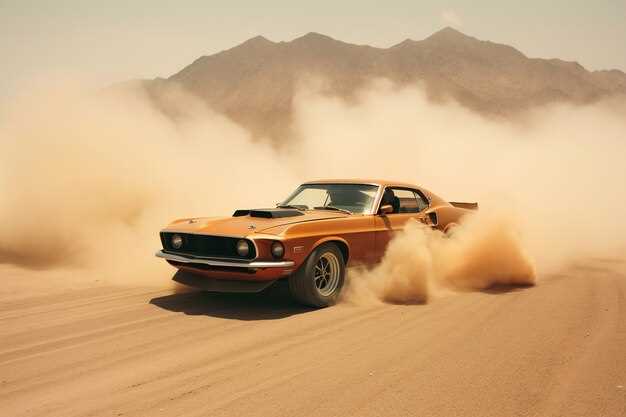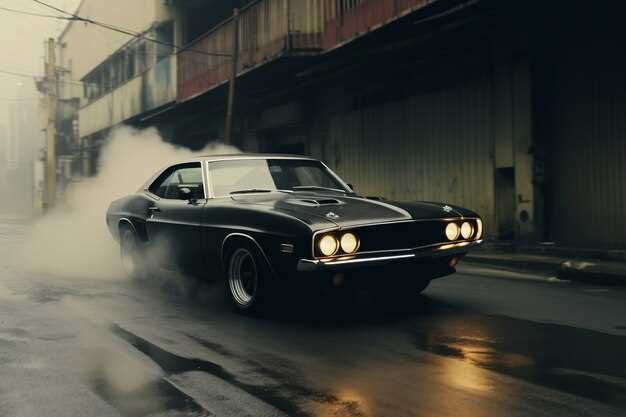
The Ford Mustang Boss 302 holds a distinctive place in American automotive history, celebrated for its performance and bold design. Introduced in 1969 during the golden era of muscle cars, the Boss 302 was created to dominate the race track and push the boundaries of engineering. Equipped with a potent 302 cubic inch V8 engine, it delivered an exhilarating driving experience that thrilled enthusiasts and captured the imagination of a generation.
Distinctive features of the Boss 302 include its unique styling cues, such as the aggressive front grille, side stripes, and functional air intakes, all designed to enhance both aesthetics and performance. The car’s lightweight construction and tuned suspension contributed to its exceptional handling, making it not just a straight-line performer, but a well-balanced sports car suitable for both the road and the racetrack.
The legacy of the Mustang Boss 302 extends beyond its impressive specifications. It became a symbol of American muscle and innovation, influencing countless enthusiasts and collectors. The 302 model not only showcased Ford’s engineering prowess but also solidified the Mustang’s status as an iconic American icon. Today, the Boss 302 continues to be revered in automotive circles, representing a rich heritage that enthusiasts celebrate and new generations aspire to experience.
Performance Specifications of the Boss 302
The Ford Mustang Boss 302 is a remarkable vehicle that showcases a perfect blend of power and precision engineering. Powered by a high-revving 5.0-liter V8 engine, the Boss 302 produces approximately 444 horsepower and 380 lb-ft of torque. This engine is designed to deliver an exhilarating driving experience, characterized by its responsive acceleration and aggressive performance.
One of the standout features of the Boss 302 is its unique engine tuning, which enhances throttle response and overall performance. The inclusion of a high-performance intake manifold and special exhaust system contributes to increased airflow, allowing the Mustang to reach a top speed of around 140 mph. The 0 to 60 mph sprint is achieved in approximately 4.2 seconds, showcasing its track-ready capabilities.
The Boss 302 is equipped with a six-speed manual transmission, providing drivers with a direct connection to the powertrain. This setup enables precise gear shifts and enhances the overall driving experience. Additionally, the vehicle features a specially tuned suspension system, which includes stiffer springs and anti-roll bars, ensuring optimal handling and cornering stability.
With its lightweight chassis and performance-focused design, the Ford Mustang Boss 302 is not only powerful but also agile. The rear-wheel-drive layout, combined with performance brakes and a limited-slip differential, further enhances the Mustang’s handling characteristics on both track and street. This model encapsulates the spirit of American muscle, delivering an unforgettable performance legacy that continues to resonate with enthusiasts today.
Design Elements that Set the Boss 302 Apart
The Ford Mustang Boss 302 is celebrated not only for its performance but also for its distinctive design elements that differentiate it from other models in the Mustang lineup. One of the most notable features is the aggressive front fascia, which includes a sculpted hood with functional air vents that enhance aerodynamics and engine cooling.
Another unique aspect is the iconic 302 logo, prominently displayed on the front fenders and rear deck, signifying its powerful 302 cubic-inch V8 engine. This emblem is a nod to both the model’s heritage and its performance pedigree. The color options available for the Boss 302 further contribute to its identity, with bold and vibrant shades like Grabber Orange and Race Red standing out on the road.
The rear spoiler, designed for improved downforce, seamlessly integrates with the car’s body lines, giving it a sporty stance that is both functional and visually striking. Additionally, the signature side stripes that adorn the Boss 302 provide a classic muscle car look, tying together its heritage with modern design principles.
Inside, the Boss 302 offers racing-inspired elements, such as Recaro front seats that provide superior support during spirited driving. The use of high-quality materials and attention to detail in the cabin reflects Ford’s commitment to blending performance with comfort. Overall, the design elements of the Boss 302 not only enhance its aesthetic appeal but also emphasize its performance capabilities, making it a true icon in the Mustang family.
Technological Innovations in the Boss 302
The Ford Mustang Boss 302, originally introduced in 1969, was not just another performance vehicle; it represented a remarkable leap in automotive technology for its time. One of the standout innovations was the powerful 302 cubic inch V8 engine, which delivered impressive horsepower and torque, making it a formidable competitor on the racetrack.
Equipped with an upgraded intake manifold, the Boss 302 engine featured specialized cylinder heads designed for increased airflow. This enhancement allowed the engine to breathe better at high RPMs, optimizing performance during demanding driving conditions. Additionally, the implementation of a high-performance camshaft contributed to a more aggressive power band, further defining the driving experience.
Another notable aspect was the transmission options available for the Boss 302. Ford offered a close-ratio 4-speed manual gearbox, which provided precise gear changes and allowed drivers to maximize the engine’s capabilities. This configuration made the Boss 302 not only fun to drive but also a finely tuned machine that appealed to performance enthusiasts.
The suspension system of the Boss 302 was another area where technological advancements shone through. It featured stiffer springs and upgraded shock absorbers, improving handling and cornering stability. This setup allowed the Mustang to navigate twists and turns with remarkable agility, solidifying its status as a muscle car legend.
Finally, the distinctive exterior design of the Boss 302 incorporated functional elements, such as an improved aerodynamic profile and vented hoods to enhance cooling. These features not only contributed to the car’s aggressive aesthetics but also played a crucial role in maintaining optimal engine performance during spirited drives.
In conclusion, the Boss 302 Mustang was a milestone in automotive innovation during its era, combining engineering excellence with raw power and style. Its legacy continues to influence Mustang design and technology even today.
Historical Significance of the Boss 302 Model

The Ford Mustang Boss 302 holds a prominent place in automotive history, reflected in its unique engineering and cultural impact. Launched in 1969, this model was designed to compete in the Trans-Am racing series, where it quickly became a formidable contender.
Key elements that underscore the historical significance of the Boss 302 include:
- Performance: The Boss 302 was equipped with a high-output 302 cubic inch V8 engine, generating impressive horsepower and torque, which made it a performance benchmark for its time.
- Racing Heritage: Developed specifically for racing, the Boss 302 solidified Ford’s reputation in motorsports. It secured numerous victories, enhancing the Mustang’s legacy as an iconic muscle car.
- Engineering Innovations: The model featured enhancements such as upgraded suspension, a unique exhaust system, and modified intake, setting new standards in performance engineering.
- Cultural Impact: The Boss 302 became a symbol of American automotive prowess, influencing pop culture through films, music, and car enthusiasts. Its image was cemented in the collective memory of car lovers worldwide.
The Mustang Boss 302 not only represents a significant engineering achievement but also embodies a spirit of competition and freedom that resonates with car enthusiasts across generations.
In conclusion, the Boss 302’s legacy is defined by its racing success, innovative design, and enduring influence, making it one of the most celebrated models in the Ford Mustang lineup.
Owner’s Experience: Maintenance and Upgrades

Owning a Ford Mustang Boss 302 is an exhilarating experience, but it also comes with its own set of maintenance requirements and upgrade opportunities that are worth exploring. Regular maintenance is crucial for keeping the engine performance at its peak, especially the high-revving V8 that makes the Boss 302 famous. Routine oil changes using high-quality synthetic oil can significantly extend engine life and performance. It’s also important to monitor coolant levels and the health of the cooling system to prevent overheating, a common concern for high-performance vehicles.
Many owners swear by the benefits of investing in upgraded cooling systems, particularly for those who enjoy track days. A high-performance radiator and upgraded fans can help manage temperatures under extreme conditions, ensuring the engine operates efficiently. Upgrading to a high-flow exhaust system is another popular modification, which not only enhances the Mustang’s iconic sound but can also improve airflow and increase power output.
When it comes to suspension, many Boss 302 owners recommend upgrading to adjustable coilovers. This modification allows for personalized tuning of ride height and damping, significantly improving handling on both the street and track. Additionally, aftermarket sway bars can reduce body roll and enhance cornering performance, making the driving experience more engaging.
As for braking upgrades, the stock system provides adequate stopping power, but many enthusiasts opt for upgrading to larger rotors and performance brake pads to reduce fade during spirited driving. This upgrade is especially important for those who frequently take their Boss 302 to the track.
It’s also beneficial to connect with the vibrant community of Boss 302 enthusiasts for tips on maintenance and upgrades. Many owners share insights on the best aftermarket parts and modifications, helping newcomers avoid common pitfalls. Overall, maintaining and upgrading a Ford Mustang Boss 302 is a rewarding journey that enhances both the car’s performance and the owner’s connection to this legendary vehicle.
Comparative Analysis with Other Mustang Models
The Ford Mustang Boss 302 stands out among the iconic Mustang lineup due to its unique blend of performance, historical significance, and design. Introduced in the late 1960s, the Boss 302 was specifically engineered for racing, making it distinct from other models such as the standard Mustang and the GT series.
One of the critical differences lies in the engine configuration. The Boss 302 is powered by a high-revving 302-cubic-inch V8 engine, which provides an exceptional horsepower output tailored for track performance. In contrast, while the Ford Mustang GT features a larger 5.0-liter V8 engine, it emphasizes a balance between power and daily drivability rather than the razor-edge focus seen in the Boss 302.
When comparing handling characteristics, the Boss 302 is equipped with upgraded suspension components that enhance its agility and responsiveness on the track. This contrasts with other models like the Mustang EcoBoost, which, while delivering impressive fuel efficiency and adequate power, does not cater to the track-focused enthusiasts in the same way the Boss does.
In terms of aesthetics, the Boss 302 showcases unique styling elements, such as specific graphics and optional race stripes, which set it apart from standard Mustangs. The performance-oriented design emphasizes its racing heritage, incorporating features like a functional hood scoop and distinctive rear spoilers, whereas more mainstream models prioritize a broader appeal and comfort over performance aesthetics.
The legacy of the Boss 302 also differentiates it from other Mustang iterations. While models like the Mustang GT and EcoBoost contribute significantly to the brand’s popularity, the Boss 302 has earned a cult following due to its historical presence in American muscle car racing and its limited production numbers. This exclusivity adds a layer of desirability and collectibility that is often not seen in more widely produced variants.
In conclusion, the Ford Mustang Boss 302 represents a unique intersection of performance, design, and history that is clearly distinguishable from other Mustang models. Whether through its powerful 302 engine, advanced handling capabilities, or rich heritage, the Boss 302 continues to hold a special place in the hearts of automotive enthusiasts and remains a benchmark against which other Mustangs are compared.




